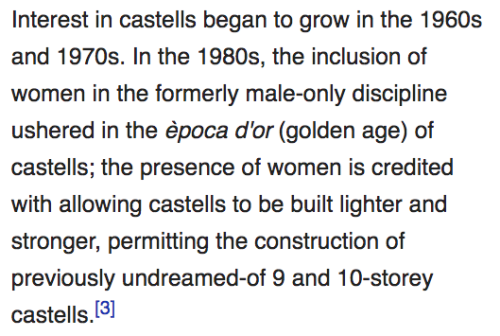jenniferrpovey:necromanticowboy:useless-catalanfacts:thepivanquisher:jamespwellington:savagedefectiv
jenniferrpovey:necromanticowboy:useless-catalanfacts:thepivanquisher:jamespwellington:savagedefectives:‘previously undreamed-of’this just gave me a glimpse into an alternate reality where human society functions the way carpenter ant society doesWe actually have something similar in India. It’s done for the festival of Janmashtami which celebrates the birth of Krishna. The story goes that when he was a baby, Krishna was always getting into pots of yogurt and white butter and just eating it by the handfuls. So his parents and village took to hanging the pots from the ceiling to keep it from him. But he and his friends would get long sticks and climb on each other’s shoulders and steal the pots anyway. So on Janmashtami now, people attempt to recreate his heist and it’s just the most adorable thing. Castellers from Catalonia found out about this tradition in India, and they thought it was amazing that we had such a similar tradition so far away. So they went to India to meet them. They filmed it all and released it as a documentary on YouTube (called Dahi Handi - Documental viatge a l’India, you can find it easily).Then in 2006, they invited a team of govindas from India to perform in Vilafranca’s square during their festivities. Vilafranca’s central square, especially during the Sant Fèlix festivities, is the place for castells. It’s the most important center for this tradition (people from Tarragona please don’t kill me for saying this but you know it’s true). And the Vilafranca colla (casteller group) is one of the best and most important ones in all Catalonia, they’re like superstars in the world of castells. So this is a huge honour to be invited by the castellers of Vilafranca. The govindas also received an official welcome in the city hall, and invited to a rehearsal of the Vilafranca castellers. They rehearsed together and then made a tower all together in Vilafranca’s central square, where the Vilafranca castellers were at the base to make the govindas’ structure stronger and higher:(The ones with white shirt and black trousers are Indian govindas, the ones with white trousers and green shirts are the Catalan castellers from Vilafranca)Everybody was very happy and the govindas and castellers got along together very well so, in 2019, 200 castellers from Vilafranca (including the mayor, who is a member) went to India to visit them again for the Janmashtami festivity (that @thepivanquisher explained) in Mumbai. The day they arrived in India, the Vilafranca castellers did some castells in front of the Gateway of India monument, ending with two pilars where the anxenetes (the kids on top) unfolded a flag of India and a flag of Catalonia.The castellers and govindas also rehearsed together in Mumbai. I’ve seen a video and it’s so lovely, it was in a square of a working class neighbourhood and it was full of people waiting to meet them. The castellers were also invited to take part in the ritual beforeJanmashtami, and they were also received by the Islamic community of a neighbourhood of the city. They were very happy to be so well received.And then the day came:(That’s govindas doing their tower and behind you can see the Vilafranca castellers, in their usual clothes, cheering for the govindas).(And that’s the castellers doing their castell after!)The castellers also performed in a school in the Mumbai and used their rest of the time there to give support to the NGO Mumbai Smiles which helps fight against poverty in the slums.(The castellers in a school)Again, they got along very well and were happy to celebrate together their shared passion. They have also learnt from each other: the Catalans showed their method to the Indians so they now can build higher towers, and by looking at how Indians climb they learned how to be faster. That’s why they have invited each other to their countries more times after that.I think it’s wonderful and I hope to see more of such exchanges (By the way, we don’t call them “human towers”. In Catalan, “castell” means “castle”. They are human castles, and “castellers”, the people who do it, means “castle-ers” or “castle builders”.)I love this I love it I love it!!!Now THAT is wonderful cultural sharing! -- source link


